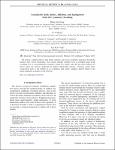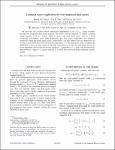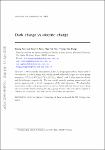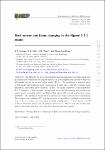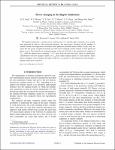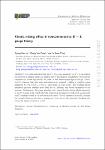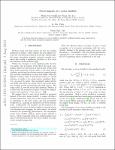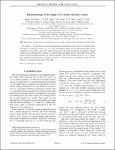Browsing by Author Phung Van Dong
Showing results [1 - 12] / 12
We show that the canonical seesaw mechanism implemented by the
U
(
1
)
B
−
L
gauge symmetry provides two-component dark matter naturally. The seesaw scale that breaks
B
−
L
defines a residual gauge symmetry to be
Z
6
=
Z
2
⊗
Z
3
, where
Z
2
leads to the usual matter parity, while
Z
3
is newly recognized, transforming quark fields nontrivially. The dark matter components—that transform nontrivially under the matter parity and
Z
3
, respectively—can gain arbitrary masses, despite the fact that the
Z
3
dark matter may be heavier than the light quarks
u
,
d
. This dark matter setup can address the XENON1T anomaly recently observed and oth... |
A new observation is that fundamental particles possess a dynamical dark charge, which governs both neutrino mass and dark matter, where the neutrino mass is determined via a canonical seesaw, while the dark matter stability is ensured by electric and color charge conservations |
We reconsider the question of electric charge quantization, which leads to the existence of a dark charge nontrivially unified with weak isospin in a novel gauge symmetry, SU(3)C ⊗SU(2)L⊗U(1)Y ⊗U(1)N , where Y and N determine the electric and dark charges, respectively. The new model provides neutrino masses and dark matter appropriately, a direct consequence of the dark dynamics. We diagonalize the fermion, scalar, and gauge sectors as well as obtain relevant interactions, taking into account the kinetic mixing of U(1)Y,N gauge bosons. The new physics signals at colliders are examined. The dark matter observables are discussed. |
We present the features of the fully flipped 3-3-1-1 model and show that this model leads to dark matter candidates naturally. We study two dark matter scenarios corresponding to the triplet fermion and singlet scalar candidates, and we determine the viable parameter regimes constrained from the observed relic density and direct detection experiments. |
It is shown that for a higher weak isospin symmetry, SU(P)L with P≥3, the baryon minus lepton charge B−L neither commutes nor closes algebraically with SU(P)L similar to the electric charge Q, which all lead to a SU(3)C⊗SU(P)L⊗U(1)X⊗U(1)N gauge completion, where X and N determine Q and B−L, respectively. As a direct result, the neutrinos obtain appropriate masses via a canonical seesaw. While the version with P=3 supplies the schemes of single-component dark matter well established in the literature, we prove in this work that the models with P≥4 provide the novel scenarios of multicomponent dark matter, which contain simultaneously at least P−2 stable candidates, respectively. In thi... |
We argue that neutrino mass and dark matter can arise from an approximate B − L symmetry. This idea can be realized in a minimal setup of the flipped 3-3-1 model, which discriminates lepton families while keeping universal quark families and uses only two scalar triplets in order for symmetry breaking and mass generation. This proposal contains naturally an approximate non-Abelian B − L symmetry which consequently leads to an approximate matter parity. The approximate symmetries produce small neutrino masses in terms of type II and III seesaws and may make dark matter long lived. Additionally, dark matter candidate is either unified with the Higgs doublet by gauge symmetry or acted as... |
It is shown that the presence of a vector doublet is suitable to address neutrino mass, dark matter, and the recent muon anomalous magnetic moment. |

